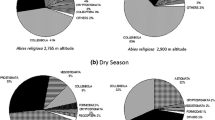Abstract
Dandelion (Taraxacum officinale) is an abundant Asteraceae species of grassland and vasteland stands. Through the vegetative season each plant produces a number of short-lived inflorescens. Final stage of inflorescence development is seed dispersal that lasts 2 days. Despite its ephemeral persistence, inflorescences at this period host abundant fauna. In 2005–2010 the inflorescences were collected in regular intervals in May–October, at Prague-Ruzyně and selected sites of western Czech Republic. Typical fauna consist of Heteroptera adults and larvae (34 species), phytophagans feeding on receptacle and seeds (mainly Miridae, Pentatomidae, Rhopalidae) and predators consuming thrips (Anthocoridae). The composition of Heteroptera fauna varies through the vegetative season, and its abundance decreases with increasing altitude of the locality. Other fauna are relics of species consuming seeds in the post-flowering phase of inflorescence maturation (mainly Thysanoptera) and occasional visitors with no trophic relationship to dandelion (Coleoptera, Diptera, Hymenoptera, Araneae). The reasons for association of phytophagous Heteroptera and dandelion may be preferences for seed consumption and chemicals present in plant tissues and possibly used for sequestration of aposematic substances.
Similar content being viewed by others
References
Aldrich J.R. 1988. Chemical ecology of the Heteroptera. Annu. Rev. Entomol. 33: 211–238. DOI: 10.1146/annurev.en.33. 010188.001235
Brown E.S. 1965 Notes on the migration and direction of flight of Eurygaster and Aelia species (Hemiptera, Pentatomoidea) and their possible bearing on invasions of cereal crops. J. Anim. Ecol. 34: 93–107.
Duffey S.S. & Scudder G.G.E. 1974. Cardiac glycosides in Oncopeltus fasciatus (Dallas) (Hemiptera: Lygaeidae). I. The uptake and distribution of natural cardenolides in the body. Can. J. Zool. 52(2): 283–290. DOI: 10.1139/z74-035
Fox C.W. & Caldwell R.L. 1994. Host-associated fitness trade-offs do not limit the evolution of diet breadth in the small milkweed bug Lygaeus kalmii (Hemiptera: Lygaeidae). Oecologia 97(3): 382–389. DOI: 10.1007/BF00317329
Free J.B. 1968. Dandelion as a competitor to fruit trees for bee visits. J. Appl. Ecol. 5(1): 169–178.
Gray E., McGehee E.M. & Carlisle D.F. 1973. Seasonal variation in flowering of common dandelion. Weed Sci. 21(3): 230–232.
Hacault K.M. & Van Acker R.C. 2006. Emergence timing and control of dandelion (Taraxacum officinale) in spring wheat. Weed Sci. 54: 172–181. DOI: http://dx.doi.org/10.1614/WS-05-083R.1
Honek A. & Martinkova Z. 2005. Pre-dispersal predation of Taraxacum officinale (dandelion) seed. J. Ecol. 93(2): 335–344. DOI: 10.1111/j.1365-2745.2005.00986.x
Honěk A., Martinková Z., Hůrka K. & Štys P. 2005. Insect community in maturing capitula of dandelion (Taraxacum officinale). Biologia 60(5): 559–565
Honek A., Martinkova Z. & Saska P. 2005. Post-dispersal seed predation of Taraxacum officinale (dandelion) seed. J. Ecol. 93(2): 345–352. DOI: 10.1111/j.1365-2745.2005.00987.x
Honek A., Martinkova Z., Saska P. & Koprdova S. 2009. Role of post-dispersal seed and seedling predation in establishment of dandelion (Taraxacum agg.) plants. Agric. Ecosyst. Environ. 134(1–2): 126–135. DOI: 10.1016/j.agee.2009.06.001
Krotkov G. 1945. A review of literature on Taraxacum kok-saghyz Rod. Bot. Rev. 11(8): 417–461. DOI: 10.1007/BF02861139
Lu Y.H., Wu K.M. & Guo Y.Y. 2007. Flight potential of Lygus lucorum (Meyer-Dur) (Heteroptera: Miridae). Envir. Entomol. 36(5): 1007–1013. DOI: http://dx.doi.org/10.1603/0046-225X(2007)36[1007:FPOLLM]2.0.CO;2
Martinková Z. & Honěk A. 2008. Contrast adaptation to time constraints on development of two pre-dispersal predators of dandelion (Taraxacum officinale) seed. Biologia 63(3): 418–426. DOI: 10.2478/s11756-008-0055-6
Martinkova Z., Honek A. & Lukas J. 2011. Viability of Taraxacum officinale seeds after anthesis. Weed Res. 51(5): 508–515. DOI: 10.1111/j.1365-3180.2011.00867.x
Mashtakov S.M., Belchikova N.P. & Leonova M.I. 1940. O produktivnosti tsvetushchikh i netsvetushchikh rastenii koksagyza (Taraxacum kok-saghyz Rod.). [Flowering and non-flowering plants of kok-saghyz (Taraxacum kok-saghyz Rod.) compared with reference to their industrial productivity]. Dokl. Akad. Nauk SSSR 28: 264–266.
Munoz A.A. & Cavieres L.A. 2008. The presence of showy invasive plant disrupts pollinator service and reproductive output in native alpine species only at high densities. J. Ecol. 96(3): 459–467. DOI: 10.1111/j.1365-2745.2008.01361.x
Nichiporovich A.A. & Bourovaya V.N. 1938. Ruber accumulation in kok-saghyz as a function of its biological maturing process. Dokl. Akad. Nauk SSSR 19(4): 311–314.
Pavlů V., Hejcman M., Pavlů L. & Gaisler J. 2003. Effect of rotational and continuous grazing on vegetation of an upland grassland in the Jizerske hory Mts., Czech Republic. Folia Geobot. 38(1): 21–34. DOI: 10.1007/BF02803125
Percival M.S. 1955. The presentation of polen in certain angiosperms and its collection by Apis mellifera. New Phytol. 54(3): 353–368. DOI: 10.1111/j.1469-8137.1955.tb06192.x
Solbrig O.T. & Simpson B.B. 1974. Components of regulation of a population of dandelions in Michigan. J. Ecol. 62(2): 473–486.
Sterk A.A. & Luteijn M.M. 1984. A study of the flowering phenology of Taraxacum microspecies in some biotypes in the Netherlands as observed during three successive years. Acta Bot. Neerl. 33: 39–59.
Šedivý J. & Honěk A. 1983. Flight of Lygus rugulipennis Popp. (Heteroptera, Miridae) to a light trap. Zeitschrift-fuer-Pflanzenkrankheiten-und-Pflanzenschutz 90(3): 238–243.
Tamanini L. 1959. I Carpocoris della Regione Palearctica. Tabella per la determinazione delle entità e loro distribuzione (Hem., Heteroptera, Pentatomidae). Memorie della Societa Entomologica Italiana 38(fasc. suppl.): 120–142.
von Hofsten C.G. 1954. Studier över släktet Taraxacum Wigg. med särskild hänvisning till gruppen Vulgaria DT i Skandinavien. Studies on the genus Taraxacum Wigg. with special reference to the group Vulgaria DT in Skandinavia. LTs Förlag, Stockholm, 431 pp.
Author information
Authors and Affiliations
Corresponding author
Rights and permissions
About this article
Cite this article
Honěk, A., Štys, P. & Martinková, Z. Arthropod community of dandelion (Taraxacum officinale) capitula during seed dispersal. Biologia 68, 330–336 (2013). https://doi.org/10.2478/s11756-013-0157-7
Received:
Accepted:
Published:
Issue Date:
DOI: https://doi.org/10.2478/s11756-013-0157-7




